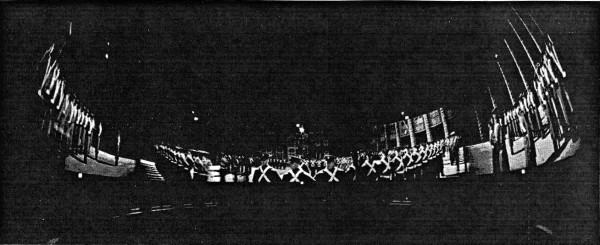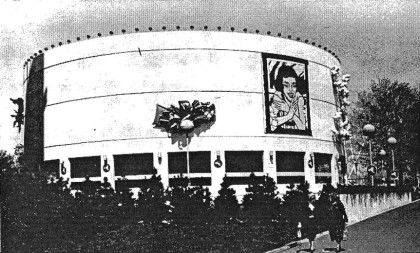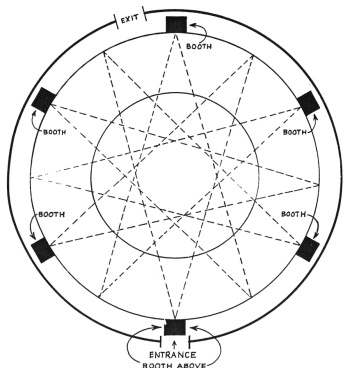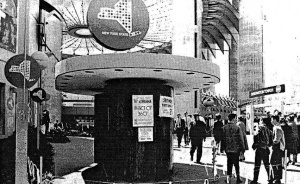A 360-DEGREE TOUR "AROUND NEW YORK"
 |
-
-
encircling
vistas of the Empire State put viewers right "in" the
action
Circular Theaterama building in which Coleman-produced
360-degree film is shown. Examples
of "pop" art are used around outside walls.
 |
|
ONE OF THE MOST novel and successful
films being shown at the Fair is A-Round New York, a 14-minute
theaterama 360-degree production being presented in the New York
State Pavilion.
|
|
Produced by Coleman Productions, Inc., the film treats viewers
to a whirlwind tour of the state, highlighting significant scenic,
industrial, cultural and entertainment centers. The feeling of
presence experienced in the 360-degree film is extraordinary.
A New 360-Degree Approach
This process differs from earlier attempts at reproducing
a total 360-degree field of view in several substantial areas.
Most significant, it utilizes 35mm film, rather than the previous
16mm, which permits a projected image of sufficient dimensions
to do justice to total all-encircling panorama.
|
Sketch of New York State "Theaterama"
building shows how the six 35mm Norelco Pulse-Lite projectors
cover equal number of 20 x 42-foot screens, encircling viewers
who stand in center on marble floor.
 |
|
Additionally, because the Mitchell Mark II cameras are equipped
with identically-matched anamorphic lenses, only six cameras
are required to complete the 360 degree horizontal coverage,
rather than the 10 or 11 cameras required by other processes.
This advantage is immediately obvious. The biggest obstacle to
be overcome in multiple projection is edge-matching. By using
only six units, the number of edges to be matched is reduced
by nearly half.
Special System Was Built
In order to more adequately fulfill his conception of Theaterama,
Harry L. Coleman, president of Coleman Productions, Inc., commissioned
the Cinerama Camera Corporation, of Hollywood, to design and
construct a multiple camera system to certain of his own specifications.
|
|
The result of their combined efforts is the 60-pound camera
set-up approximating the shape of a cylinder -- 48 inches high
by 52 inches in diameter, including 1000-foot magazines.
The six Mark II's are mounted vertically on a pedestal, shooting
up into a turret of six front-surface mirrors, arranged to present
a 45 degree surface to each lens. Without this feature, the cameras
would necessarily be mounted horizontally, shooting outward like
spokes of a wheel.
In the latter arrangement, the edges of the angle of view
originating at the nodal point of each individual lens could
not possibly correspond. Thus, at close range, a subject passing
from the field of view of one camera to that of another would
be lost from sight during that interval.
Avoiding the Loss of Field
By establishing an effective nodal point for all cameras (hypothetically
dead center of the system) and reflecting the field accepted
at this common point into each individual lens, there is no loss
of field at any distance from the lens, from minimum to infinity.
This is the value and necessity of the optically-correct, perfectly-aligned
turret of mirrors.
|
Source: BUSINESS
SCREEN MAGAZINE Presented courtesy Eric Paddon Collection
|
Reducing the number of cameras, thereby providing more uninterrupted
screen in projecting 360-degrees, created optical problems which
challenged the best engineering minds in the business. Since
each of the six cameras must accept a full 60 degrees of horizontal
coverage, a lens with a focal length of not more than 40mm is
required. A 40mm lens could not accept the necessary anamorphic
addition without vignetting. |
View of the New York State area with Theaterama
ticket booth in fore-ground. A modest 25c
admission is charged for the 12-minute picture.
 |
|
|